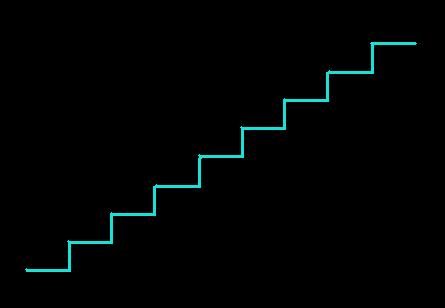

This section is a continuation of Part V which covered algorithms for constructing 15th and 45th order Siamese and Uniform Step squares using new computer algorithms. This section will explore the sequence first introduced in that section and will show why only certain orders of n produce squaretype tables containing no diabolic squares. Most importantly it will also be shown that the sequence follows the order n1 n2 n3 n4 n5 n6 ... where the struck-out terms, after division by three, are present as lower terms in the sequence. The struck-out terms may then be considered as secondary, tertiary, etc., numbers which can be generated from the non-struck primary terms via threefold multiplication.
The sequence is composed of terms which are all divisible by three:
and also present in the OEIS database with the Sloane number of A016945 with the formula:
This sequence has found a new niche in that, as said before, the terms signify the order n of squaretypes which are divisible by three and, therefore, do not have diabolic magic squares as any of their entries in the squaretype tables. To analyze the sequence we will tabulate the terms, divide each term nx by three and determine whether:
| (a) nx/3 is already in the sequence |
| (b) nx/3 is divisible by 5 |
| (c) nx/3 is the product of two equal primes, i.e., a prime squared | (d) nx/3 is the product of two non equal primes |
The first thing we do is to set up the sequence as follows in the following table (as a group of six rows), where the first rows are the terms of the sequence and the second rows are each term in the sequence divided by three, nx/3. We then apply the four conditions (a) thru (d). First we either scan the second row and everytime a number is present in both rows that term in the sequence is struck out, or we can take the easy route and use the equation 18n+9 to accomplish the same. These struck-out terms, again, are not primary terms but secondary, tertiary, etc., terms which can be constructed from the primaries.
Whatever terms are left over in the second row, excluding the blue terms, are either prime or non prime numbers. And since it is only n order primes that can generate diabolic squares our attention must be focused on the non prime composite numbers for analysis by (b), (c) and (d). Therefore, whenever we encounter a prime in row two we do nothing since it is not possible to generate a primary term by multiplying a prime by 3. Which means that any unstruck term in row one that sits above a prime in row two must be a primary term.
| n | 3 | 15 | 21 | 33 | 39 | 51 | 57 | 69 | 75 | 87 | 93 | 105 | 111 | 123 | 129 | 141 | ||||||||||||
|---|---|---|---|---|---|---|---|---|---|---|---|---|---|---|---|---|---|---|---|---|---|---|---|---|---|---|---|---|
| nx/3 | 1 | 3 | 5 | 7 | 9 | 11 | 13 | 15 | 17 | 19 | 21 | 23 | 25 | 27 | 29 | 31 | 33 | 35 | 37 | 39 | 41 | 43 | 45 | 47 | ||||
| n | 147 | 159 | 165 | 177 | 183 | 195 | 201 | 213 | 219 | 231 | 237 | 249 | 255 | 267 | 273 | 285 | ||||||||||||
| nx/3 | 49 | 51 | 53 | 55 | 57 | 59 | 61 | 63 | 65 | 67 | 69 | 71 | 73 | 75 | 77 | 79 | 81 | 83 | 85 | 87 | 89 | 91 | 93 | 95 | ||||
| n | 291 | 303 | 309 | 321 | 327 | 339 | 345 | 357 | 363 | 375 | 381 | 393 | 399 | 411 | 417 | 429 | ||||||||||||
| nx/3 | 97 | 99 | 101 | 103 | 105 | 107 | 109 | 111 | 113 | 115 | 117 | 119 | 121 | 123 | 125 | 127 | 129 | 131 | 133 | 135 | 137 | 139 | 141 | 143 | ||||
If we inspect all second rows (even subsequent rows not shown) and apply (b) to numbers that have not been struck out, we get the sequence below with the Sloane number A063149 in the OEIS database:
which we can generate with the initial condition of:
followed by the recursive formula:
and where each term is the product of two or more primes. This means that these terms cannot be used to generate primary terms in row one because their squaretype tables contain a number of diabolic square symbols. For instance, we cannot construct a 105th order squaretype table from three 35th order tables, since a 35th order squaretype table contains 8 diabolic square symbols just in the first row (as verified using the new Staircase computer program in Part IV) So that the 105th order square must be constructed from scratch, i.e, it is a primary term, which in the table above can be used to produce the secondary struck-out term 315.
Condition (c) where nx/3 is a prime squared are known to produce squaretype tables that contain diabolic squares as shown in Part III Con't. In condition (d) those terms that are the product of two or more primes (excluding 5), for example:
have squaretype tables with a number of diabolic square symbols and, therefore, are neither primary terms or terms in the original sequence, viz., row one.
This completes this section (Part VI). To go back to Part V. To return to homepage.
Copyright © 2021 by Eddie N Gutierrez. E-Mail: enaguti1949@gmail.com